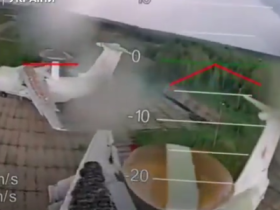Instead of traipsing blindly through the byzantine labyrinth that is the regular defense acquisition process to modernize its nearly 40-year-old M1 Abrams tank, the U.S. Army Chief of Staff Gen. Randy George has ordered the service and its industry partners to move much more quickly to get something better, his chief technology officer, Dr. Alex Miller, told Defense News.
“We don’t want to turn into Pentagon Wars,” Miller said in a recent interview at the Pentagon, referring to a satirical comedy exposing bureaucratic dysfunction of the 1970s development of the Army’s Bradley Infantry Fighting Vehicle.
The Army has long adhered to acquisition timelines in which a program could be greenlit, but then take a decade to proceed through technology maturation “so that the government can feel comfortable and understand all the potential risks that could ever happen,” Miller said. “Because you have to understand all of the environment and all the technology so well that the decision you make today is right for 30 years, and that doesn’t make sense anymore.”
The Army decided in September 2023 that it would pursue a more significant modernization effort for the Abrams tank, rather than go through with planned upgrades to increase the tank’s mobility and survivability on the battlefield.
The service then awarded a contract to General Dynamics Land Systems — Abrams’ original equipment manufacturer — in the spring of 2024 to begin shaping requirements and work on a preliminary design of the new tank variant.
Vague desires for the new variant included making it lighter, better protected and giving it an autoloader.
But little has been revealed over the last year about those plans, except that the Army wanted to align the fielding of the new M1E3 with the fielding of its Bradley replacement, the M30 Mechanized Infantry Combat Vehicle, which is expected in the early 2030s.
‘Accept risk’
Shortly after becoming Army chief about 18 months ago, George was told in a meeting with Program Executive Office Ground Combat Systems in Detroit, Michigan, that the new tank would take 65 months before the first one would be built, Miller recounted.
Finding the timeline astronomical, George promptly ordered the team to figure out a way to move much faster.
“In the last two or three months, we’ve been given a lot of latitude to go, ‘Hey, stop doing silly things, supercharge where you need to supercharge, accept risk where it is responsible and pragmatic,’” Miller said, “‘Don’t encumber yourself on policies and regulations that were made for different pieces … Use all of the things that are legally, morally and acceptable available and stop trying to manage all the risk to the point where there’s no risk because there will always be risk.’”
The Army is now planning to cut the timeline down to a third of that original projection, with a plan of getting a new variant out to soldiers within 24 to 30 months, Miller said.
“We are taking advantage of all of the authorities that we can and just go,” he said. “I’d like to see this before I retire.”
The Abrams tank has many elements that work well, Miller said, such as the 120mm smooth bore gun and its fins and skirts, for example. However, “the things we really want to get after are, ‘Hey, what’s happened in the last 40 years for drivetrain? What’s happened in the last 40 years for power generation?’” he said.
Farther afield for the new Abrams would be an autoloading capability. A tank autoloader is technologically difficult and will likely take more time because it is a unique problem for the military.
“We’ve been staring at [the problem] for 10 years,” Miller noted. Now, the Army wants to see how industry can solve it technologically while ensuring it is specifically designed to work within the tank.
But there are many other capabilities that are readily available within the commercial heavy machinery world, for example, that could be applied in those areas related to drivetrains and power, according to Miller.
The Army also wants to integrate active protection into the tank and believes it can go more quickly in that realm as well, he said. The service has only managed to kit out Abrams with Israeli defense firm Rafael’s Trophy Active Protection System. The system is not fully integrated into the tank, which leads to a series of undesirable tradeoffs.
RELATED
The potential for rapid improvement of even interior ergonomics or tank control systems and targeting is on the table.
“There’s no reason that can’t look like an F1 cockpit because the technology exists,” Miller said.
The effort requires the Army to partner with industry in a different way, he noted. “What if we actually partnered with industry and said, ‘You make some of the tradeoffs internally,’ let industry Lego together the right thing instead of the government trying to pretend like we know everything about it.”
“The cool thing here is letting [industry] choose the parts and pieces actually allows them to build their supply chain,” Miller said, which is important for better supply chain stability.
Potential pathfinder
The Army plans to award a contract as early as May for GDLS to be able to pursue rapid selection and adoption of new capabilities for a modernized tank. “Then it’s off to the races in terms of making sure that GD has all the right players in place and all these things are modular,” Miller said.
“Where we strangle the defense industrial base is, we don’t let them self-organize around a problem,” Miller said. “We over-specify the solution and then we get mad when they deliver exactly what we asked for and we give them no flexibility.”
The service will take a similar approach to how it brings in software capability, where more trust is placed in program managers to accept appropriate risk. Hardware typically requires sign-off at the highest levels, and moving up the chain is a lengthy process.
“We’re going to make sure all the designers and all of the testers and all of the users are together from day one so that by the time that thing rolls off, we know it’s safe. We know it will work, and then we just get it into hands of users,” Miller said.
The Army already has a funding line for M1E3 in its budget, so the service will be able to proceed and execute the program within the next five years’ budget cycle. If the program was a new start, it wouldn’t be possible to proceed, as the government is operating under a continuing resolution that funds the Defense Department at the prior fiscal year’s funding levels.
If the effort to accelerate M1E3 is successful, it could lead to greater acquisition reform.
RELATED

“It is a pathfinder for doing things differently,” Miller said. “It is a pathfinder for process change and innovation. I think when we get a win here, we’ll be able to look at other programs and go, ‘Hey, you can do the same thing.’”
The effort comes at a time when President Donald Trump’s administration is embarking on acquisition reform initiatives, following the signing of an executive order earlier this month. Part of that order includes a review of all major defense acquisition programs.
“If we weren’t thinking about this and getting caught blindsided, it would not be in a good space,” Miller said. “I’m actually very confident that [this] falls right in line with that.”
Jen Judson is an award-winning journalist covering land warfare for Defense News. She has also worked for Politico and Inside Defense. She holds a Master of Science degree in journalism from Boston University and a Bachelor of Arts degree from Kenyon College.
Read the full article here







Leave a Reply